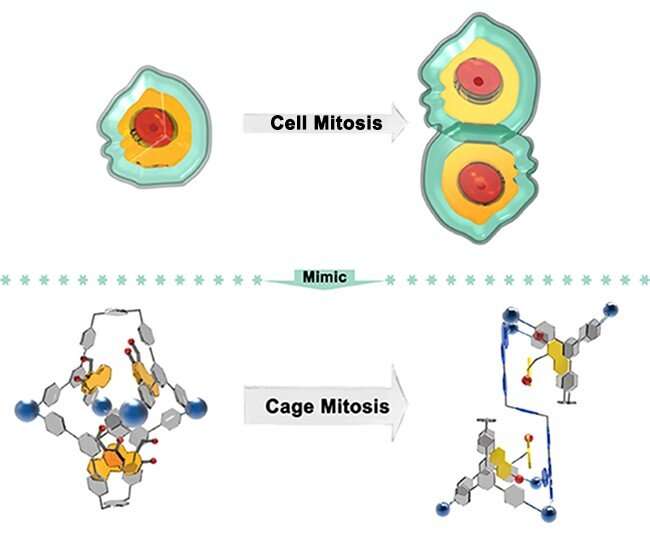Researchers reveal guest-reaction-driven cage to conjoined twin-cage, mitosis-like host transformation

Guided by the induced-fit mechanism, guest-templated synthesis offers an important route toward otherwise inaccessible complicated host-guest complexes. In this case, guest molecules with specific sizes, shapes and electrostatic interactions are usually added to the system from the beginning to drive the formation of the new complementary complexes.
However, guest-reaction driven structural conversions, i.e., the new products generated in situ from the initial added guests exert the induced-fit power to force the structural transformation of the host, are extremely rare.
In a study published in Angewandte Chemie International Edition, a research group led by Prof. Sun Qingfu from Fujian Institute of Research on the Structure of Matter (FJIRSM) of the Chinese Academy of Sciences, revealed a guest-reaction induced mitosis-like host transformation from a known Pd4L2 cage to a conjoined Pd6L3 twin cage featuring two separate cavities.
The researchers chose 1-Hydroxymethyl-2-naphthol, a known o-QMs precursor, as the guest in this study. o-Quinone methides (o-QMs) are known as a group of important intermediates in total synthesis of natural products and pharmaceutical compounds. Due to their biradical or polarized zwitterion ketene structures, o-QMs are highly reactive toward hetero Diels-Alder or nucleophilic additions.
Interestingly, they observed a guest-reaction induced mitosis-like host transformation from Pd4L2 cage to an unprecedented conjoined Pd6L3 twin cage.
Formation of a (1-Hydroxymethyl-2-naphthol)4ìPd4L2 cage host-guest complex was indicated by 1H NMR spectra. The theoretic discussion showed that, up to 7.57 M local concentration of 1-Hydroxymethyl-2-naphthol in the confined cavity and thus triggering its spontaneous dimerization reaction to generate 2,2'-dihydroxy-1,1'-dinaphthylmethane in situ. 2,2'-dihydroxy-1,1'-dinaphthylmethane triggered the mitotic process from Pd4L2 cage to the conjoined molecular Pd6L3 twin cage, which was mainly driven by strong π-π interaction.
Additionally, the researchers revealed that this transformation from the Pd4L2 cage to a conjoined Pd6L3 twin cage has several unique features which are the same in a particular way as the cell-mitosis. The process is driven by an internal reaction. The mother Pd4L2 cage has one cavity and the produced Pd6L3 cage has two separate cavities. The building units of the cages before and after the transformation are the same.
This study sheds light on natural phenomena such as enzyme deactivation and allosteric protein regulation.
Chemical-triggered structural transformations are commonly observed in biosystems. Moreover, the motions of these natural systems correspond to essential biological functions. Assembled supramolecular architectures offer controllable platform at the molecular level to mimic the function of biosystems.
More information: Pei-Ming Cheng et al. Guest-Reaction Driven Cage to Conjoined Twin-Cage Mitosis-Like Host Transformation, Angewandte Chemie International Edition (2020). DOI: 10.1002/anie.202011474
Journal information: Angewandte Chemie International Edition
Provided by Chinese Academy of Sciences





















